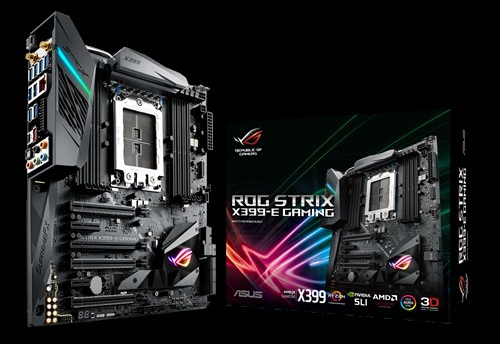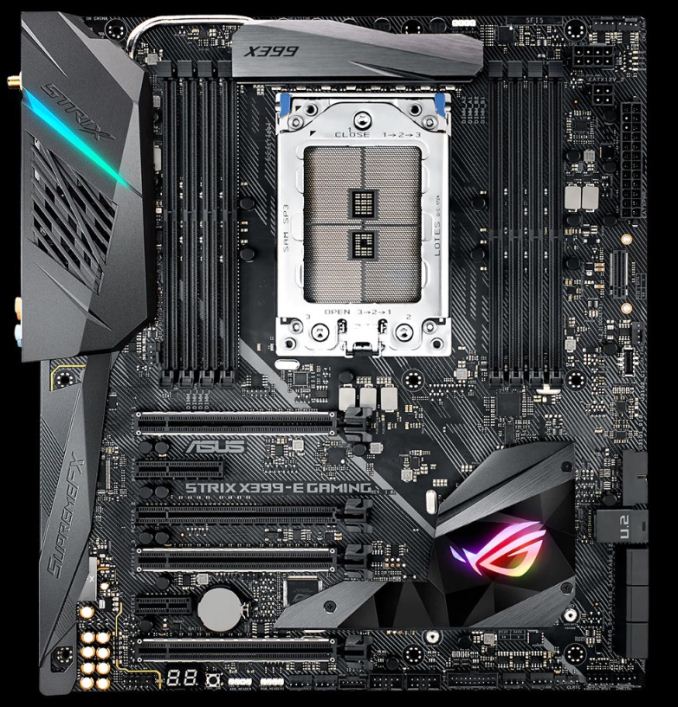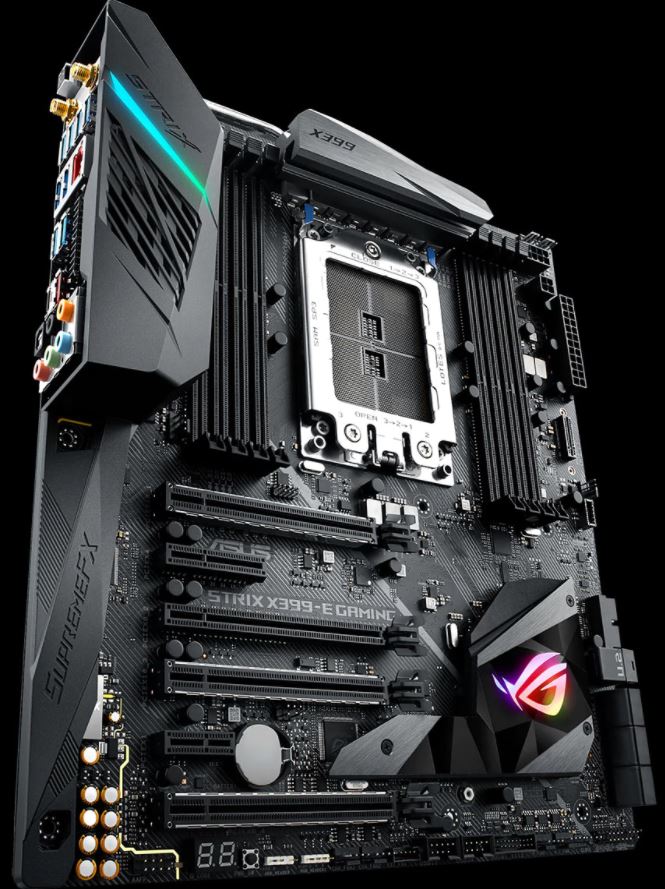An AMD Threadripper X399 Motherboard Overview: A Quick Look at Seven Products
by Ian Cutress & Joe Shields on September 15, 2017 9:00 AM ESTASUS ROG Strix X399-E Gaming
With the advent of eSports and the ability to stream and even broadcast your own gaming sessions, PC gaming has gained a significant amount of momentum the past few years. So much so, many (if not all) of the motherboard partners have latched on to the nomenclature and started entire lines for 'gaming' motherboards. ASUS is no different with gaming based motherboards, out for generations now under the ROG name, and continues to do so on the X399 Threadripper platform in the ROG Strix X399-E Gaming. Strix as a brand has migrated from a 'zero-noise' implementation to the more budget oriented gaming products from ASUS.
The ROG Strix falls between the Zenith Extreme and the Prime with a mix of features. For example, the Strix includes WiFi and Bluetooth connectivity, like the flagship Zenith Extreme, or that the Prime and Strix each have a single Intel I211-AT Gigabit LAN while the Zenith has three network ports including a 10 GbE. The Strix X399-E Gaming has eight DRAM slots, supports multiple GPUs (SLI and Crossfire), uses the latest audio codec (Supreme FX S1220A for the Strix), a capable VRM, multiple storage options, and RGB lighting among other features.
Looking over the board in detail, we'll start at the top. First, the VRM configuration is an eight-phase design. It is cooled by dual heat sinks running along the top of the socket with the second sitting between the memory slots and rear I/O. Extra cooling on the VRMs is provided by an included 40mm fan sitting under the I/O shroud (similar to the Zenith). Both EPS connectors, an 8-pin and 4-pin, as well as the 24-pin ATX connector, are in the top right-hand corner of the board. Below that is the second M.2 slot. An M.2 drive in this slot, like in the Prime, sticks out from the board instead of laying flat. ASUS does include an M.2 bracket for the slot to assist with supporting the standing device.
Continuing to move down the motherboard, below the vertical M.2 slot is the USB3.1 (10 Gbps) header fed from the chipset. For cases that have front panel USB 3.1 ports, this is typically the header used for that connectivity. Below that is the single U.2 port and six SATA ports.
The chipset heatsink on the ROG Strix houses RGB LEDs that can be adjusted with the AURA Sync software. The only other LEDs on the board are located on the I/O cover. The chipset heatsink extends on the bottom between the last two full-length PCIe slots and covers the first M.2 slot providing additional cooling for those devices.
The Strix offers four full-length PCIe slots, three use a reinforcing guard and is where users will slot their graphics cards for optimal performance. The PCIe arrangement allows for up to a triple slot video card between slot 1 and slot 3, and a dual slot card will fit between between slot 3 and slot 4. Slot breakdowns are x16 for single, x16/x16 for dual GPUs, and x16/x16/x8 when using three GPUs. Additionally there is one PCIe x1 slot, a PCIe x4 slot, and full-length PCIe slot (x4). These slots distinguish themselves by not having the reinforcement.
Across the bottom of the board are more onboard headers. These include external addressable RGB LED headers, fan headers, and USB3.0 headers. It also has a debug display as well as a small power button for testing outside of the case. On the left side of the board is where the audio parts are housed. Mostly concealed under the shroud is an EMI protected ALC1220A codec using upgraded filter caps, and PCB separation of the audio components from the rest of the board.
The rear I/O panel is fairly busy with a BIOS reset button, wireless connectivity, eight USB 3.0 ports, and the Gigabit Ethernet port taking up most of the real estate. USB 3.1 Type-A and Type-C ports from the ASMedia controller are also present, with the audio jacks, including SPDIF output, rounding out the rear panel.
| ASUS ROG Strix X399-E Gaming | |
| Warranty Period | 3 Years |
| Product Page | Link |
| Price | N/A |
| Size | ATX |
| CPU Interface | TR4 |
| Chipset | AMD X399 |
| Memory Slots (DDR4) | Eight DDR4 Supporting 128GB Quad Channel Up to 4133 MHz (OC) |
| Network Connectivity | 1 x Intel I211-AT GbE |
| Wireless Network | Wi-Fi 802.11 a/b/g/n/ac |
| Onboard Audio | SupremeFX S1220A |
| PCIe Slots for Graphics (from CPU) | 4 x PCIe 3.0 x16 Supports SLI/CF |
| PCIe Slots for Other (from Chipset) | 1 x PCIe 2.0 x4 (max) 1 x PCIe 2.0 x1 |
| Onboard SATA | 6x Supporting RAID 0/1/10 |
| Onboard SATA Express | None |
| Onboard M.2 | 2 x PCIe 3.0 x4 - PCIe or SATA |
| Onboard U.2 | 1 x PCIe 3.0 x4 |
| USB 3.1 | 1 x Header 1 x Rear Panel Type-A 1 x Rear Panel Type-C |
| USB 3.0 | 8 x Rear-Panel 2 x Header |
| USB 2.0 | 2 x Header |
| Power Connectors | 1 x 24-pin EATX 1 x 8-pin ATX 12V 1 x 4-pin ATX 12V |
| Fan Headers | 1 x M.2 1 x CPU 1 x CPU OPT 3 x Chassis 1 x AIO_PUMP 1 X w_PUMP+ 1 x 5-pin EXT_FAN |
| IO Panel | 1 x Intel NIC 1 x USB 3.1 Type-A 1 x USB 3.1 Type-C 8 x USB 3.0 1 x Optical S/PDIF out 5 x Audio jacks 1 x USB BIOS Flashback Button 1 x 2x2 Wi-Fi 802.11 a/b/g/n/ac |
ASUS mentioned pricing for the Strix X399-E Gaming to be at a more affordable price than their flaghsip ROG Zenith Extreme. It is currently available through smaller distributors, perhaps as a pre-order, but not found on Newegg or Amazon at the time of writing (9/11).













99 Comments
View All Comments
HStewart - Friday, September 15, 2017 - link
You got to give some credit to AMD clever marketing teams by naming this x399 when Intel has x299 and then calling this the "The Most Advanced Desktop Motherboard in the World"But in reality there is no Thunderbolt 3.0 support and most likely be updated next year or later with PCIe 4.0 support.
Does it support DDR4-4600?
AMD sure likes to play numbers game and not just chipset name - but with number cores - just remember it mostly marketing - yes it still 16 cores - but 16 cores by one manufacturer does not mean 16 cores from completion.
sartwell - Friday, September 15, 2017 - link
Where is the high speed RAM? You cannot get it anywhere.HowardJones - Friday, September 15, 2017 - link
If you're considering the ROG Zenith be aware that it's having tons of problems overclocking CPU and memory. Theres a huge thread on overclock dot net that is filled with people having problems with the bios. There WAS an Asus rep who was trying to help, but he's pretty much disappeared in the last few weeks.tamalero - Sunday, September 17, 2017 - link
Seems like your average typical Asus mainboard.Asus has really huge troubles in their software segment. I still remember they needed like 50 patches to get their high end routers stable. And yet they couldnt get all what they promised in a working condition and even disabled some stuff in later firmwares.
Same with bioses.
I still remember a time where you had to enable the "floppy" connector in a motherboard (even if you had no drive) if you wanted the bios to actually apply the overclocking settings.
mapesdhs - Tuesday, September 19, 2017 - link
A note for those with older ASUS ROG and other ASUS X79 boards, etc.: there's a thread on the ASUS ROG forum site where a guy has provided modded BIOS files to support booting from NVMe devices, aswell as rolling in all the updates to the latest microcode, Intel RAID, etc. Very handy indeed, and he takes requests for other ASUS boards. SSDs like the 950 Pro have their own boot ROM, but a BIOS with boot support is perfect for the 960 EVO/Pro and other models which don't have their own boot ROM.I just bought two R4Es (one basically new), a 4930K, a 16GB/2400 DDR3 kit and a 120mm AIO for a total of 320 UKP. Who needs new stuff? :D My next new build will be TR or EPYC though I'm sure.
satai - Saturday, September 16, 2017 - link
Are any details on X399 AORUS Gaming 7 power delivery solution?The rumor was, that the used only 8 phase, but 8s this true for the final design?
danjw - Saturday, September 16, 2017 - link
The Asus Zenith Extreme claims to support 4-way SLI, but I thought Nvidia didn't support 4x slots for SLI? Am I wrong? Or is this a false claim?DanNeely - Saturday, September 16, 2017 - link
Cynically I'm going to guess that if you use several generation old cards that did support 4 way SLI you could combine all 4 together for an act of supreme WTFery.danjw - Saturday, September 16, 2017 - link
I looked at the manual for the Zenith Extreme. It claims the two that the block diagram of the board in this review indicates are 4x are 8x, with the lowest one on the board being 8x as long as you don't have a U.2 drive connected to the U.2 port. So, it is unclear which is correct the block diagram or the manual.danjw - Sunday, September 17, 2017 - link
Apparently, the block diagram wasn't clear. That last slot is 8x/4x depending on if you have a U.2 drive connected.